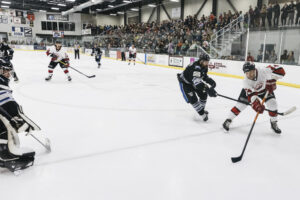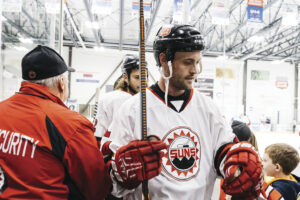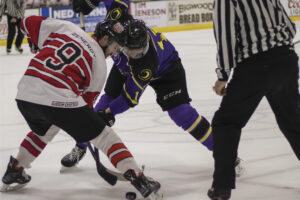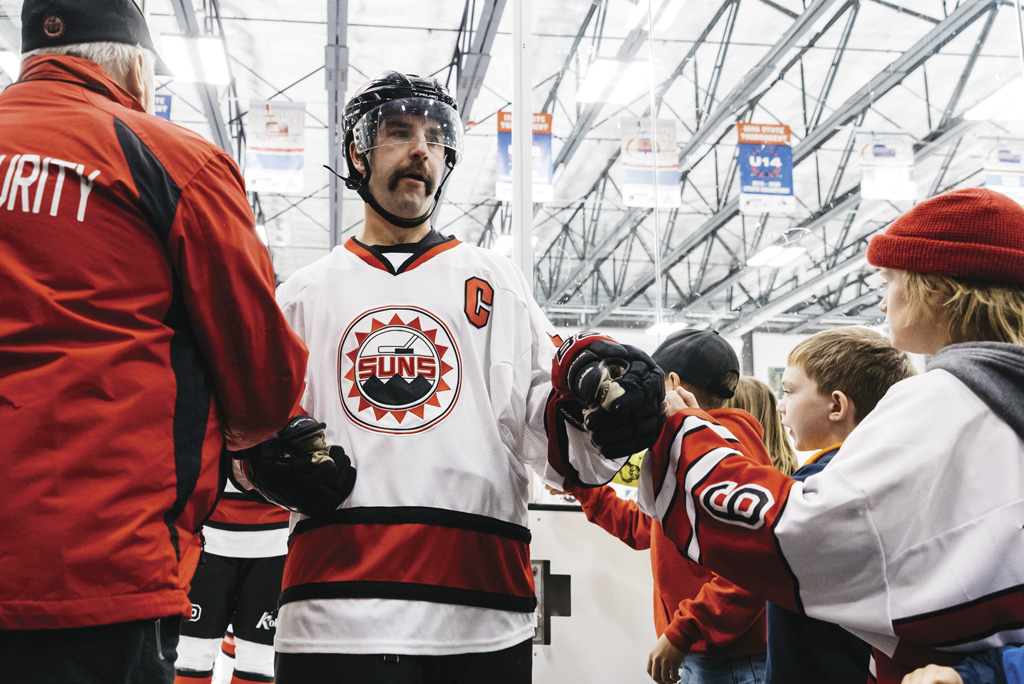Imagining Ketchum and Sun Valley without skiing is impossible, especially with the 2024-25 World Cup Finals coming for the first time to Baldy in March and Sun Valley’s 90th anniversary in 2026. Skiing is the gold standard here. Sun Valley’s storied history begins on skis and just on skis.
But when Ice Hockey came to Sun Valley in 1975, the sport brought new vitality and energy to the town. With the sport came the state-of-the-art indoor ice rink, which was built next to the existing outdoor rink. Very soon after the arena opened, the Sun Valley Suns men’s hockey team was born, and they are still going strong—50 years later!

The Suns have been a competitive hockey club longer than some NHL teams.
How strong? The Suns have played 1,097 games in 49 seasons at Sun Valley Indoor Ice Rink and, for the last nine years, also at Campion Ice House in Hailey. Nearly 350 players from the US and Canada have suited up in the Suns jersey. An increasingly robust youth hockey program has also been launched, utilizing the state-of-the-art facility.
Suns teams have traveled internationally for games and competed in national senior tournaments. But more importantly, Suns players have captured the heart of a mountain community with their willingness to compete at a high level and party with the best!
Right from the start, “A ski town also became a hockey town,” says Suns president of hockey operations John Burke from Duluth, Minn., an original Suns player in 1975.
Like many early Suns alumni like Bobby Noyes, Chris Benson and Glenn Hunter, Burke has unselfishly served as a player, coach, organizer, fund-raiser and booster. He said, “We’ve had our ups and downs over 50 years. But the community embraced us from the start. The players and Suns culture kept things going.”
And now, in 2024, it’s hard to imagine the Valley without hockey. Suns hockey has become family entertainment, and the players have become family. In 2022, the Suns celebrated its first-ever third generation of players with John Weekes, Beets Johnson and Parker Weekes.
The longevity of the Suns is otherworldly. No other Senior Elite men’s hockey team in the country has lasted as long. Only St. Nick’s Hockey Club of New York City, established in 1896, is comparable, but St. Nick’s doesn’t play a regular schedule of games like the Suns.
The Suns have lasted longer than 12 National Hockey League teams, but despite the loyalty of its active Alumni Association, the team’s survival has never been assured.
From Ski Town to Hockey Town
It was an inauspicious start in December 1975, as many hockey enthusiasts skated a couple of times a week on the outdoor rink—which had no sideboards, flimsy metal frames for nets and an abbreviated skating surface.
Change was imminent. General contractor Herman Maricich estimated that the indoor rink was built between the fall of 1974 and the summer of 1975 for $450,000. Wealthy hockey enthusiast George Gund III underwrote much of the cost. The land on which the rink was built was leased from Sun Valley Resort for 15 years at $1 a year.

There’s never a time when a Suns player won’t make time for a youngster.
Gund’s constant support was the glue holding the Suns financially together for its first half-century, just as he was also an integral part of USA Hockey nationwide during the formative period of American hockey growth from 1975-2000.
Former Suns general manager Charlie Mills, who worked 34 years for the Gund family, says, “George was the major investor, and he was always there for the Suns. He loved the Suns. He liked the idea of just having fun to play hockey.”
Young hockey players from the hockey-mad Duluth (Minn.) community followed the lead of original Suns captain Hermie Haavik and streamed into Ketchum. “Duluth played a big part,” says original Suns player Alex Orb. “For all the players who came out here, they might have turned out the lights in Duluth.”
A 1978 feature article about the Suns by Clayton Kyle in the National Hockey Magazine was headlined “Hockey Invades Ski Country.”
Talented young hockey players came to Sun Valley not for the pay—since there wasn’t any pay to play—but because they liked the mountains and the lifestyle. The article helped put the Suns on the map nationally.
Word got around. Indeed, Vilnis Nikolaisons, the all-time leading Suns scorer, grew up in Riga, Latvia, under the Soviet Union and its successful state system of hockey and first came to North America in 1998.
Nikolaisons played with his Latvian friend Ivars Muzis for the Tacoma Sabercats of the West Coast Hockey League, which visited Sun Valley for an exhibition game in October 1998. Nikolaisons was eventually cut from Tacoma, but Suns coach Tim Jeneson convinced him to come to Sun Valley for the winter.
Nikolaisons played 13 years for the Suns, ran his own business and raised a family here. He and Muzis, who followed him to Sun Valley, are still ranked No. 1 and No. 18 on the Suns all-time scoring list.
The selfless nature of hockey players has been vital over the years. Hockey players want to play hockey, just as skiers prioritize skiing. Burke says, “There’s a passion for hockey from a young age. It’s a game with all kinds of unwritten rules and behavior toward others. You are playing because you love the game. You watch out for each other. You take care of the new guys. Nobody judges. It’s a unique culture.”

The Sun Valley Suns don’t just bring the intensity of the ice; they bring fun and fan involvement to the Wood River Valley.
Suns current general manager Sean O’Grady says, “There’s humility among hockey players, a lot of tongue-in-cheek humor and self-deprecation. Nobody thinks they are better than anyone else. You try to play a role in helping the team. Really, you can’t put into words what has gone into 50 years of Suns hockey.”
Certainly, the formation of the non-profit Suns Foundation in 2004, thanks to the efforts of PGA golf pro Davis Love III, and the arrival of the Suns Alumni Association two years ago, put the franchise on sounder footing. Weekend benefit nights started by Hunter in the 1990s jump-started the community outreach of the Suns Foundation.
But what the Suns really needed for success was a place to call home.
Hailey Ice, Inc., was a non-profit corporation established in 2000. For many years, it provided the community with free outdoor skating in Hailey. The high usage convinced Hailey Ice that building a fully enclosed ice area was essential.
In 2010, Hailey Ice was part of a general obligation bond that allowed it to lease city property at Wertheimer Park to build a new skating facility. An aggressive fund-raising campaign started in 2012 provided Hailey Ice with lead donations totaling $1 million.
The Lynn Campion family invested $4 million more to fully enclose the arena. This sizable donation provided momentum for raising another $6.5 million to complete the facility, which opened its doors for the first time as Campion Ice Area in November 2015.
It’s been a big success story over its first decade. Hailey Ice executive director Sarah Benson said that Campion Arena counted 50,000 visits over the past year, including all its recreational and practice offerings and a popular curling league.
Because of increased usage by different groups, Benson said Campion Ice Arena is now open 10 months a year instead of the original seven months a year schedule.
Sun Valley Youth Hockey has significantly contributed to Campion Arena’s community economic engine. For 2024-25, nine weekend tournaments are planned from October through March—from 8-and-under (8U) through high school. Out-of-town college hockey teams are leasing Campion for games.
SVYH registrar Nancy Fenn says her program had welcomed 3,573 participants, a yearly average of 223 in groups from 6U Mini Mites to 10U Squirts, 12U Pee Wees, 14U Bantams, 19U girls and high school since 2008.
The young skaters exclusively used Sun Valley Skating Center for games and practices before 2015. In the nine years since Campion Arena opened, 2,309 kids have signed up for SVYH, an average of 256 a year, topped by program records of 303, 331 and 322 since 2021.
Suns pioneer Alex Orb also founded Sun Valley Youth Hockey with John Weekes and Bob Cadiente in February 1977. Suns players stepped up as coaches. “We were players. None of us had coached,” Orb says. “But we wanted to learn. We sought out Joe Marmo of Idaho Falls and found ways to earn coaching credentials through USA Hockey.”
“I think we had 30 kids that first year,” Orb adds. “People thought we were nuts to start it because of the enthusiasm for skiing. What we found out was not everybody wanted to ski, so the program picked up quickly, and we doubled the number of kids the second year.”
SVYH reached a milestone in 2023 when its boys’ high school hockey team went 42-6-4 and won eight tournaments, including the Minnesota Chipotle 1A Youth Tier 2 national championship. It is a prominent banner among the dozens hanging at Campion Arena.
“Are we creating a feeder program for the Suns? Yes!” says Burke, acknowledging many former SVYH players on recent Suns teams.
Fans have responded to the family atmosphere at Suns games.
The Suns’ attendance at Campion games has steadily risen. In 2017, they drew 5,582 fans on 14 home dates. In 2018, they drew 8,183 fans on 19 home engagements, including the Black Diamond Hockey League tournament. In 2019, they drew 7,705 fans on 19 dates.
By 2023, the Suns’ attendance was 9,181 fans in 18 home games. Last year, it was 12,137 in 19 Suns home games. Burke said, “Campion Ice House has been a real plus for us in solidifying our fan base.”
Burke adds, “When I got here in 1975, it worked perfectly in my life. I just loved it—it was so much fun to be here, and the hockey was some of the best in the country. Suns hockey has given me so much more than I’ve given it—the friendships and, of course, the life in the valley.”


